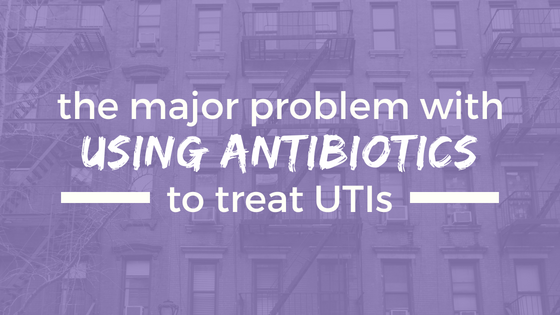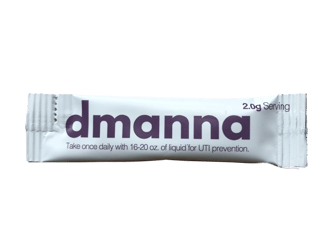Urinary tract infections are painful, persistent, and sometimes debilitating infections that often leave us feeling like someone other than ourselves. They affect our sex lives, our relationships, our physical and mental wellbeing and by association, nearly every aspect of our lives.

At least half of all women will suffer a urinary tract infection in their lifetimes, and between 20% and 30% of those with an acute infection will have a recurrence within 3 to 4 months.1
Antibiotics Are The Most Common Treatment For Active UTIs
Currently, antibiotics are the only known effective treatment for an active urinary tract infection (although some women report success with natural remedies like Dmanna). For women with recurrent urinary tract infections, doctors recommend either self-start, post-coital, or continuous low doses of antibiotics. These methods can be effective, but there’s a problem.
Antibiotics And Their Side Effects
Although antibiotics are often life-saving, they can have side effects like nausea and diarrhea. More damaging “last-resort” antibiotics like Cipro can even cause nerve damage. Because of these potential side effects, the FDA recently updated their drug safety label for fluoroquinolones like Cipro, recommending they only be used for patients with no other options.2
When we overuse antibiotics, our immune systems are weakened, leaving us susceptible to other infections. The CDC suggests that “at least 30 percent of antibiotics prescribed in the United States are unnecessary.”3
SEE ALSO: 9 Mind-Blowing Myths About UTI Prevention
Antibiotic-Resistant Superbug MCR-1 Gene
Bacteria are becoming increasingly resistant to antibiotics. More and more cases of the MCR-1 gene (resistant to all known antibiotics) are appearing.
The Atlantic puts it well in their article about a Nevada woman who died of a multi-resistant infection last year:
“You might pick up some bacteria…carrying resistance to colistin. Years later, you might pick up some bacteria with a plasmid carrying resistance to carbapenems…They start swapping plasmids…Then you get sick, your immune system is down, and you take antibiotics for an infection. The antibiotics kill everything but the resistant bacteria, which have by now collected all the resistance genes and no competition. That’s how you get a pan-resistant infection.”4
What Happens When There Are No Antibiotics Left?

CDC Director Tom Frieden told The Washington Post that the discovery of MCR-1 in human patients “basically shows us that the end of the road isn’t very far away for antibiotics—that we may be in a situation where we have patients in our intensive-care units, or patients getting urinary tract infections for which we do not have antibiotics.”5
SEE ALSO: I've Tried Everything: What To Do If You Have A UTI
The Good News: UTI Prevention Tools
The saddest part about urinary tract infections with multi-resistance to antibiotics is that the situation is entirely preventable. There are two very important lifestyle changes you need to make to prevent recurrent urinary tract infections.
Drink More Water
This is very important. The more water you drink, the more you will flush out the harmful bacteria from your urinary tract, preventing them from attaching to your urinary tract.
One study followed 140 women over a 12-month period. Half of the women increased their water intake by an average of 1.15 liters per day each, bringing their daily average to 2.8 liters. The other group averaged 1.2 liters total every day. The study found that the group that drank 2.8 liters reduced their UTI recurrence rate by nearly 50% compared to the control group who only drank 1.2 liters a day.6

What Does That Mean For Me?
To prevent UTIs, drink up to 3 liters daily to be on the safe side.
Take Daily D-Mannose For UTI Prevention
The other important lifestyle change is to take d-mannose every day. D-mannose is a natural sugar found in berries and other fruit. It is not a treatment, but a daily prevention supplement. D-mannose does not alter normal vaginal floral or kill good bacteria like antibiotics do. While short, frequent courses of antibiotics can increase the frequency of urinary tract infections, http://www.dmanna.comw has been proven in many clinical trials to greatly reduce UTI recurrence.7
“UTI kept returning despite 3 courses of antibiotics. I called a doctor I knew in Sacrament who specializes in natural remedies. He told me about D-mannose and sent some to me over-night. I started taking it on a Tuesday. By Wednesday the pain was gone. By Thursday the pressure was gone. I kept taking it for two more days. The UTI left and did not come back.”
WebMD PemMom
Here’s a video on how D-mannose works to prevent urinary tract infections.
Dmanna: The Best D-Mannose Supplement For UTI Prevention

Dmanna is a UTI prevention tool for patients experiencing chronic and frequent UTI symptoms. The daily stick powder packets contain pure d-mannose, a natural sugar found in many fruits like peaches and cranberries.Dmanna users avoid harmful antibiotics by including Dmanna into their daily health routines with its convenient, pre-measured packets to kill UTIs before they develop.
Ready to wave goodbye to your recurring urinary tract infections? Click below to get started with Dmanna today!
- Host-Pathogen Checkpoints and Population Bottlenecks in Persistent and Intracellular Uropathogenic E. coli Bladder Infection
- Recurrent UTIs in women: How you can refine your care
- CDC: 1 in 3 antibiotic prescriptions unnecessary
- A Woman Was Killed by a Superbug Resistant to All 26 American Antibiotics
- Doctors Find Superbug Resistant To All Antibiotics In Pennsylvania Woman
- Drinking More Water Reduces Repeat Urinary Tract Infections
- Host-Pathogen Checkpoints and Population Bottlenecks in Persistent and Intracellular Uropathogenic E. coli Bladder Infection
.png?width=165&name=manna%20(3).png)





.png?width=320&name=Dmanna%20Blog%20Featured%20Image%20(1).png)

